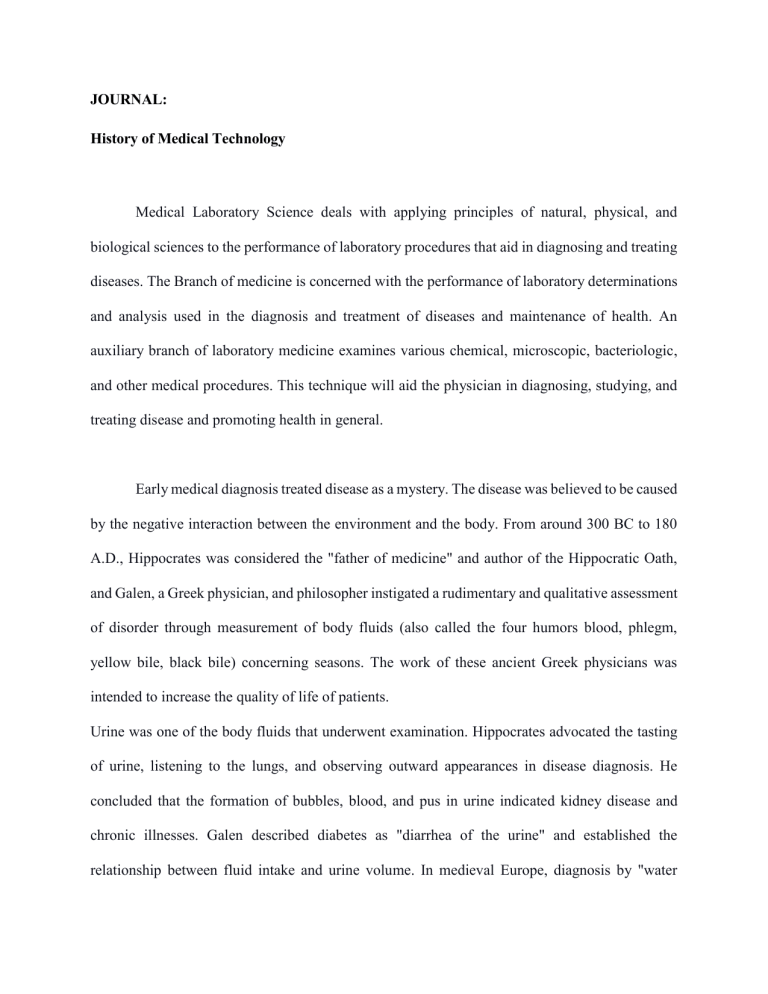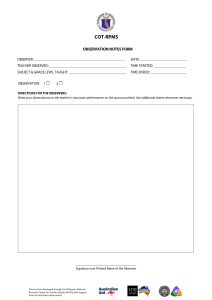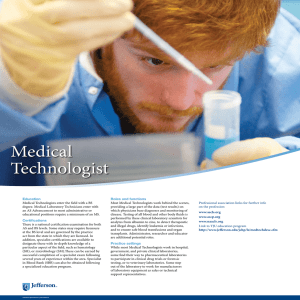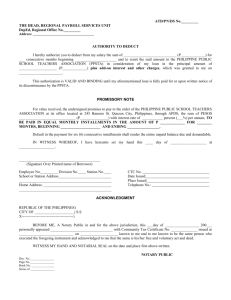
JOURNAL: History of Medical Technology Medical Laboratory Science deals with applying principles of natural, physical, and biological sciences to the performance of laboratory procedures that aid in diagnosing and treating diseases. The Branch of medicine is concerned with the performance of laboratory determinations and analysis used in the diagnosis and treatment of diseases and maintenance of health. An auxiliary branch of laboratory medicine examines various chemical, microscopic, bacteriologic, and other medical procedures. This technique will aid the physician in diagnosing, studying, and treating disease and promoting health in general. Early medical diagnosis treated disease as a mystery. The disease was believed to be caused by the negative interaction between the environment and the body. From around 300 BC to 180 A.D., Hippocrates was considered the "father of medicine" and author of the Hippocratic Oath, and Galen, a Greek physician, and philosopher instigated a rudimentary and qualitative assessment of disorder through measurement of body fluids (also called the four humors blood, phlegm, yellow bile, black bile) concerning seasons. The work of these ancient Greek physicians was intended to increase the quality of life of patients. Urine was one of the body fluids that underwent examination. Hippocrates advocated the tasting of urine, listening to the lungs, and observing outward appearances in disease diagnosis. He concluded that the formation of bubbles, blood, and pus in urine indicated kidney disease and chronic illnesses. Galen described diabetes as "diarrhea of the urine" and established the relationship between fluid intake and urine volume. In medieval Europe, diagnosis by "water casting" (uroscopy) was widely practiced. Patients submitted their urine specimens in decorative flasks. Physicians who failed to examine the urine were subjected to public beatings. By 900 AD, the first book detailing the characteristics of urine (e.g., color, density, quality) was written. From these early documented works, medicine and medical technology advanced because of the high mortality rate caused by plagues and other diseases. In the early 11th century, medical practitioners were not allowed to examine the patient's body physically. Thus, they relied solely on the patient's description of symptoms and their observations. By the 18th century, mechanical techniques and cadaver dissection were used to provide a more objective and accurate diagnosis and understand the body's insides. In the 19th century, physicians began using machines for diagnosis or therapeutics. Among these devices were John Hutchinson's spirometer for measuring the vital capacity of the lungs and Jules Herisson's sphygmomanometer for measuring blood pressure. Also, the use of chemistry was pivotal in diagnosing diabetes, anemia, diphtheria, and syphilis during this period. The onset of mechanical and chemical devices spurred the turn from general practice to specialization. The increasing number of patients brought about this turn, and the increasing amount of medical knowledge generalists could no longer handle. More complex machinery and equipment in medical practice required technical expertise, resulting in cooperative arrangements among specialists in different fields. Consequently, medical services became organized in hospitals. With this setup, large amounts of data were required in the diagnosis and treatment of patients. These volumes of patient data prompted the need for information technology. The demand for medical technicians and data specialists also increased. In 1969, 80 percent of medical professionals were nonphysicians. This growth propelled the need for technicians to be proficient in the use of technology. Patients were likewise needed to be educated on the tests done on them. Technology took over face-to-face interaction between patients and physicians who relied more on technology as the basis for diagnostic assessments instead of patient's subjective descriptions of symptoms. All these resulted in increased diagnostic accuracy at the expense of a closer doctorpatient relationship. The thermometer, stethoscope, microscope, ophthalmoscope, laryngoscope, and X-ray are some breakthroughs in medical technology that allowed physicians to examine body parts that used to be observed only in cadavers. In the mid-1800s, laboratories designed for analyzing medical specimens were organized by chemical experts. Specialized laboratories regulated by the Centers for Disease Control and Prevention (CDC) began to be used for medical diagnostics in the US by the mid-1900s. In the early 20th century, improvements in basic sciences and integration of scientific and technological discoveries (i.e., electrical measurement techniques, sensor developments, nuclear medicine, and diagnostic ultrasound) marked the advances in medical technology; medical technologies also impacted various surgical procedures. Further integration of technology with science ushered in new medical advancements such as the electron microscope, new medical imaging technologies, and prosthetic devices. The electron microscope gave way to the visualization of small cells, including tumor cells. The adaption of computers in medical researchers led to the development of tomography and magnetic resonance imaging (MRI). Prosthesis such as artificial heart valves, artificial blood vessels, functional electromechanical limbs, and reconstructive skeletal joints was also developed due to these innovations. Medical technology breakthroughs persist through robotics, keyhole surgery procedures, genetic engineering, and telemedicine (information technology). Medical technology has improved quality of life and increased life expectancy. However, this progress resulted in the reevaluation of traditional definitions of life and death. In the United States, the establishment of the first clinical laboratory development of laboratory practice marked the growth of the medical techno 1895. The University of Pennsylvania's William Pepper Laboratory of Clinical man opened to highlight the service role of clinical laboratories. In 1918, John Kolme developed a method that would certify medical technologists on a national Kolmer published The Demand for and Training of Laboratory Technicians that included a description of the first formal training course in Medical Technology. In the same year, the state legislature of Pennsylvania enacted a law requiring all hospitals and institutions to have a fully-equipped laboratory fit for routine testing and to employ a full-time laboratory technician. In 1920, the administrative units of clinical laboratories in large hospitals were directed by a chief physician. During this time, clinical laboratories consisted of 4 to 5 divisions, including clinical pathology, bacteriology, microbiology, serology, and radiology. As clinical laboratories held more prominence in the delivery of laboratory tests, the need for technicians and technologists that would assist physicians became greater. In 1922, the American Society for Clinical Pathology (ASCP) was founded with the objective of encouraging the cooperation between physicians and clinical pathologists as well as maintaining the status of clinical pathologists. ASCP also established the code of ethics for technicians and technologists, stating that these allied health professionals should work under the supervision of a physician and refrain from making oral or written diagnoses and advising physicians on how patients should be treated. The American Society for Clinical Laboratory Science (formerly the American Society for Medical Technologists), which was initially formed as a subgroup of ASCP, helped recognize nonphysician clinical laboratory scientists as autonomous professionals. In the 1950s, medical technologists in the United States sought professional recognition from the government for their educational qualifications through licensure laws. On January 9, 1945, 850 US ships of the 6th US Army began a round-about to Lingayen Gulf, attempting to mislead the Japanese. Manila was taken, and Corregidor was liberated. Finally, real medical facilities were made available to the Philippines, which include the 26th Medical Laboratory of the 6th US Army. The said laboratory was located at 208 Quiricada Street, Sta. Cruz, Manila, but now known as the Public Health Laboratory; a division of the Manila Health Department. As early as February of that year, training of civilians to become members of the healthcare team was already being done. The 6th US army left the laboratory in June 1945. The National Department of Health endorsed the laboratory, but the department didn't seem to be interested in pursuing the objectives of the laboratory. The 2nd World War ended in September 1945, and barely a month later, the laboratory was formally reorganized by Dr. Pio de Roda and assisted by Dr. Mariano Icasiano. He was then the Manila City Health Officer. The laboratory was later named Manila Public Health Laboratory. A training program for individuals aspiring to become laboratory workers was offered in 1947 by Dr. Pio de Roda in collaboration with Dra. Prudencia Sta. Ana. Trainees mainly were high school graduates and paramedical graduates. The training proved to be ineffective because the trainees were never motivated and there was no program that was supposed to last for a set period of time, and no certificates were issued to the trainees. Realizing this, Dr. Pio de Roda instructed Dra. Sta. Ana to prepare a formal syllabus of the training program. In 1954, the training began using a syllabus, and it was to last six months. The training program offered by Dr. Pio de Roda did not last long because, during that same year, the formal education of Medical Technology in the Philippines began. History of Medical Technology in the Philippines During World War II, the Philippines was seriously affected. Japan invaded Pearl Harbor on December 7, 1941. Three days later, Japan conquered the entire Philippines, causing the wrath of the United States to flare up. Illnesses and death were very evident. The Board of Medical Technology was created in 1970 according to Republic Act 5527, also known as the "Philippine Medical Technology Act of 1969." The law recognized medical technology as a profession and defined the practice of medical technology, subject to the registration and regulation policies of the government. The first Board was composed of Dr. Arturo D. Tolentino, Jr. as Chairman and Mr. Felix E. Asprer and Ms. Azucena S. J. Vizconde as Members. The Board administered the first examination for Medical Technology in September 1970, where only twenty-five percent of the examinees passed. In order to upgrade the quality of graduates, the Board established mutual relations with the Philippine Association of Schools of Medical Technology and Hygiene (PASMETH) in developing and updating the course syllabi to improve the performance of schools in the licensure examinations. The Bachelor of Science in Medical Technology/ Medical Technology offers a four-year program consisting of general education and professional courses. The fourth-year level is the one-year internship program in a Commission on Higher Education (CHED)-accredited training laboratory, with rotational duties in different sections, such as Clinical Chemistry, Hematology, Microbiology, Immunohematology (Blood Banking), Immunology and Serology, Urinalysis and other Body Fluids (Clinical Microscopy), Parasitology, Histopathologic/Cytological Techniques, and other emergent technologies. Through the years, the Board has ensured that medical technologists are able to perform the responsibility of aiding physicians in the diagnosis, study, and treatment of diseases and in the promotion of health in general. On the other hand, the Philippine Association of Medical Technologists, Inc., otherwise known as the PAMET, is the national organization of all registered Medical Technologists / Medical Laboratory Scientists in the Philippines. It is a non-stock, non-profit organization. The association was organized by Mr. Crisanto Almario (recognized as the Father of PAMET), who felt the need to standardize the profession and sought to improve and upgrade the practice. PAMET was born on September 15, 1963, at the Public Health Laboratory at 208 Quiricada Street, Sta, from the initial pre-organizational planning and conceptualization. Cruz, Manila. The first national convention was held at the Conference Hall of the Far Eastern University Hospital on September 20, 1964, where Mr. Charlemagne Tamondong became the first President. Initially, with a handful of intrepid visionaries, the association steadily grew. Undaunted by the seemingly impossible difficulties, the membership of PAMET worked toward the passage of Republic Act 005527, known as "The Philippine Medical Technology Act of 1969". The law defined the practice of Medical Technology. The law further recognized Medical Technology as a profession, subject to registration and regulation by the government. It was enacted into law on June 21, 1969. It was incorporated and registered with Reg at the Securities and Exchange Commission on October 14, 1969. No 39570 during the presidency of Mr. Nardito Moraleta. A few days before the declaration of Martial Law on September 21, 1972, President Ferdinand Marcos declared the 3rd week of September as a celebration of the Medical Technology profession. On June 22, 1973, PD 223 was approved, creating the Professional Regulation Commission (PRC). PAMET was officially recognized as the only Accredited Organization (APO) of registered Medical Technologists in the Philippines. In the last decade, the focus of PAMET was to widen membership and establish chapters. The LAB NEWS, which was later changed to PAMETLINK, its official publications had its inaugural issue. PAMET is a national body with forty-six (46) provincial chapters nationwide divided into four (4) regions such as North Luzon, South Luzon, Visayas, and Mindanao Region and three international affiliates PAMET Singapore, Eastern Region the Middle East, and Western Region Middle East. PAMET collaborates with other local professional associations, namely, Council of Professional Health Associations (COPHA), Philippine Federation of Professional Association (PFPA), Council of Health Agencies of the Philippines (CHAP), Philippine Council for Quality Assurance in Clinical Laboratories (PCQACL), and Philippine Association of Schools of Medical Technology and Public Health and Hygiene (PASMETH). It is also linked with other government agencies such as the Department of Health (DOH) and the Commission on Higher Education (CHED). In the nineties, PAMET took great strides in its campaign for national recognition. It sought to break its isolation from an organization that has primarily worked in the narrow confines of its internal borders. PAMET engaged in federal programs in cooperation with other institutions and actively pursued its membership in international organizations. PAMET became involved with different projects of the Department of Health, the Wash Hand Campaign, and Scholarship Programs for Medical Technology students with Procter & Gamble, Phils, and with the Japan International Medical Technology Foundation (JIMTEF), where it sends scholars to Japan for study grants and transfer of technologies in the field of Microbiology, Immunology, and Leadership. Continuing Professional Education has been undertaken throughout the years, even before the PRC mandated the renewal of licenses. It speaks of the commitment to encourage its members to learn new technologies and update knowledge. Internationally, PAMET is a member of the ASEAN Association of Clinical Laboratory Sciences (AACLS), Asia Association of Medical Laboratory Scientists (AAMLS). PAMET became a member of the Asia-Pacific Federation of Clinical Biochemistry and Laboratory. For 50 years, the PAMET has gone through the difficulties of being a neophyte and has emerged as a robust and stable organization prepared to immerse itself in national and local interest issues. It is going into the next millennium, intending to provide improved benefits for its membership and strengthen the image of the Medical Technology professional. To further the development of the course, PASMETH, also known as the Philippine Association of Schools of Medical Technology and Public Health, was formed. It is the national organization of all recognized schools of Medical Technology in the Philippines. On May 13, 1970, Director Narciso Albarracin appointed Dr. Serafin Juliano and Dr. Gustavo U. Reyes to organize Deans/Heads of Schools of Medical Technology and Hygiene Association. The first organizational meeting was held at the University of Santo Tomas on June 22, 1970. The first sets of officers were: President - Dr. Gustavo Reyes Vice-President - Dr. Serafin Juliano Secretary/Treasurer - Dr. Velia Trinidad Press Relations Officer - Dr. Faustino Sunico. It was formed in 1970 in the hopes of maintaining the highest standards of Medical Technology/Public Health education and fostering closer relations among these schools. With the impending liberalization of trade in services, the Board actively participates in the Consultative Meetings of PRC regarding the ASEAN Negotiations on Services and Mutual Recognition Agreement. It coordinates with the Philippine Association of Medical Technologists (PAMET) and other CPE providers to improve professionals' professional skills and values systems and adopt the latest technological developments in their field. Today, medical technologists serve in hospital and free-standing laboratories, clinics, pharmaceutical companies, schools, food and cosmetic industries here and abroad. Since then, the country has been molding medical technologists for the world health industry who are scientifically and technologically competent to deliver the full spectrum of Medical Technology services required in modern health care. References: History of Medical Technology in the Philippines. (2017, May 21). Retrieved from https://graduateway.com/history-of-medical-technology-in-the-philippines/ Misamis University. (n.d). History and Development of Medical Technology. Retrieved September 20, 2021 from MT-LAW-1.pdf - 1 MT Laws Bioethics#1 \u2013 REVISED REVIEWER#1 HISTORY AND DEVELOPMENT OF MEDICAL TECHNOLOGY MEDICAL TECHNOLOGY 1 Ruth Heinemann the | Course Hero Professional Regulation Commission. (n.d.). Philippine Medical Technology Act of 1969. Retrieved September 20, 2021 from Medical Technology | Professional Regulation Commission (prc.gov.ph) Florento, L. (n.d.). PAMET Brief History of The Philippine Association of Medical Technologists. Retrieved from IFCC histories_Philippines.pdf Reyes, G. (2013, June 18). StudyMode Research. Journal of the History of PASMETH. 1(1-2). Retrieved September 19, 2021 from Journal on University and Dr. Gustavo Reyes Bartleby Research. (n.d). Medical Technology in the Philippines. Retrieved September 19, 2021 from Medical Technology in the Philippines - 1863 Words | Bartleby






